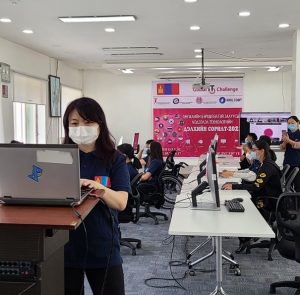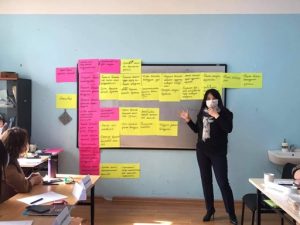By Ganchuluun Turbat
Our guest is Ms. Altmaa, Director of the School of Vocational Education and Skills at the Mongolian National Rehabilitation Vocational Training Center. She shared her views on vocational education of the people with disabilities.
Vocational Training
The School for Vocational Education and Skills (Trades) provides specialized training in professions such as chef, baker, tailor, carpenter, souvenir crafter, graphic designer, and cellphone repair technicians, through 1-2.5 years of schooling. According to Ms. Altmaa, the school admits around 140 students with all types of disabilities at the different levels, except for blind individuals. For blind students, it is the Vocational Training Center of the Mongolian National Federation of Blind that provides specialized training. Ms. Altmaa’s school has a dormitory for 20-25 resident students and the class size is usually around 8-12 students depending on the level of disability levels. The school has been running for over 45 years and staffs experienced faculty members who help these young adults acquire special sets of trade skills. Their students come at different age groups, ranging from their teens to the mid-40s. The school evaluates each student at the beginning in order to tailor the vocational training programs for each student’s need and type/level of disability.
One And A Half Years Longer Than Other Vocational Schools
There is one major challenge: The school receives older students with disability, but they have never been to schools – some with hearing disability do not know the sign language or alphabet. This is mostly the fault of their parents or guardians. Many of them never have let them study at secondary schools for a variety of reasons. Then, suddenly, they realize these young adults need to acquire certain skills and choose a profession to be employed or to make their living. This requires the school to reduce the number of students and create additional programs to help these students in their 20s, 30s and 40s, to obtain some of the elementary and secondary school knowledge and skills (e.g., writing, reading, counting, and sign language) in addition to their specialized trades certificate programs. Therefore, many of their students need to complete the trades skills training over 2-2.5 years. Although there are some improvements in including children with disabilities in elementary and secondary school, Ms. Altmaa encouraged parents with disabled children to provide their kids with the opportunity to study as early as possible.
Getting on the Job Market
There are some improvements in the job market. “Many businesses have been working with us to employ our graduates”, Ms. Altmaa mentions. Jobs in high demand by the market are chef, baker, tailor and carpenter. Some companies seek cleaning and service workers, but the school does not provide training in such trade skills. The majority of carpenters, cellphone repair technicians, and engravers become easily self-employed. The school follows up their graduates after six months and after one year upon their employments. The retention of employment is low. “There are several reasons”, as Ms. Altmaa explains. One is that their graduates are not well prepared to handle the initial challenges of working in a new environment (e.g., routine, staff, co-workers, workload) and it could be personal. Another challenge is on the employers’ side – they are not prepared to deal with disabled employees. As soon as they find the initial difficulties, the employer seeks ways to fire the disabled employee. Another difficulty is posed by inaccessible infrastructure (e.g., the facility’s wheelchair accessibility). Lastly, parents prohibit the employment for them to take care of family matters instead, not respecting the rights of the disabled people (to see elders or children, or to manage household chores). Ms. Altmaa highlights that the school is now increasing the number of classes and also expanding the classes’ skill sets to improve the communication skills of their students. As several of our guests pointed out, there should be more collaboration between the employer and a school and the disabled employees to find a better solution to create an inclusive employment atmosphere.
New Programs Being Introduced with the EU
Before 2000, all vocational schools used to design their own programs based on their own studies. Today, the Ministry of Labour and Social Welfare oversees the process of designing and accreditation of programs for vocational schools. Although the law requires having special vocational programs for the people with disabilities, we still don’t have specific programs for the people with disabilities. However, with assistance from the European Union, we are in the process of introducing three new professions (i.e., service worker, e-service person, and clerk) for the disabled students based on the studies and discussions of non-governmental organizations, employers, brokers, and people with disabilities. The school is planning to admit new students for these new programs. Since it is based on a thorough study of the job market, Ms. Altmaa does not expect any difficulties for students graduating with these new professions.
Lack of Human Resources
In developed countries, there are about eight staff members per student, including teacher, doctor, psychologist, and assistant, of course, depending on the degree of the disability. But, in Mongolia, the ratio is opposite: 8-15 students per teacher. Even though the standard requires a teacher-student ratio of 1:8, the school tries to include more students. A major challenge is posed by the shortage of trained and experienced instructors who could work with people with all types of disabilities. All faculty members, who were educated in the Soviet Union in methods to work with disabled people, are retired. To fill the gap, the Ministry of Education have introduced a graduate level program for teaching to the people with disabilities and mandatory pedagogical course. But the effects are slow. Since the school operates on a tight state budget, the school could not hire more teachers and staff. The school now requires all new faculty to have a bachelor’s degree and to learn the sign language. In real terms, it usually takes about 1-2 years to be competent enough to work with students with disabilities.
At the moment, everyone at the school needs psychologists. Faculty and staff need to be trained and counselled on how to deal with students and their parents. Moreover, the mental health of students is important. “We always feel the need of psychologists to deal with parents and family members of our students”, Ms. Altmaa adds.
Impacts of the COVID-19
The COVID-19 has affected the school’s operation severely. Unlike for other students, it is impossible to carry out online schooling because students with disabilities need to have a more practical and hands-on training. The school is already two years behind of the schedule. Since students could not complete the required practical training hours, they could not graduate.
It was an insightful interview about the vocational educational programs for the people with disabilities. Ms. Altmaa wishes to increase the school’s capacity (e.g., learning space, dormitory) to reach out to many students who could not join the school because of the limitation. Moreover, she hopes the school to do more work in regard to rehabilitation and introducing international standards.
About the Author: Ganchuluun Turbat is about to start his master’s program at the Naval Postgraduate School, Monterey, California. He graduated from the Mongolian National Defense University and logistical officer’s courses in the United States. In the military, he served in multiple peacekeeping missions, including the United Nations Mission in South Sudan and NATO Training Mission in Afghanistan.
The Untold podcast and blog post are made available by the generous support of the Friedrich Ebert Foundation in Mongolia. We also want to thank our editor Riya Tikku.



 Follow
Follow